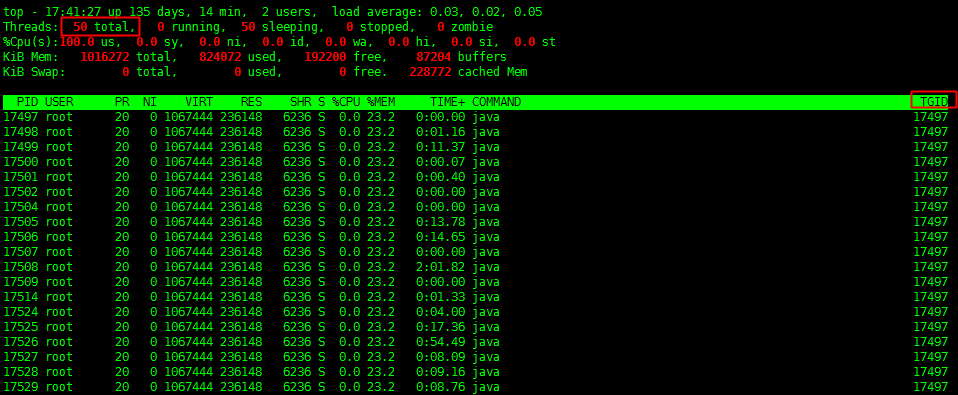C语言编程中pid, tid以及真实pid的关系(转)
add by zhj: 下面是我对pid,tgid,ppid的个人理解
对于ubuntu14.04操作系统,可以在/usr/src/linux-headers-4.4.0-31/include/linux/sched.h文件中看到进程控制块的结构体,如下
struct task_struct { volatile long state; /* -1 unrunnable, 0 runnable, >0 stopped */ void *stack; atomic_t usage; unsigned int flags; /* per process flags, defined below */ unsigned int ptrace; #ifdef CONFIG_SMP struct llist_node wake_entry; int on_cpu; unsigned int wakee_flips; unsigned long wakee_flip_decay_ts; struct task_struct *last_wakee; int wake_cpu; #endif ...... ...... pid_t pid; pid_t tgid; ...... ...... }
可以看到,里面定义了两个字段,pid和tgid,其中pid就是这个轻量级进程lwp的id,而tgid是轻量级进程组的id,当创建进程时,我们可以为自己指定
进程的tgid字段,貌似可以随便指定,只要存在就行,另外在父进程中,可以为子进程设置进程组id,如果没有指定,它会继承父进程的进程组id。
还有一个概念ppid,我没在这个结构体中找到,但操作系统肯定是会记录的,在Python中,通过os.get_ppid()就可以获取当前进程的父进程。tgid与ppid,
这两者其实没有任何关系,因为tgid是可以自己来指定的,平时基本不用,不用管它。
原文:http://blog.csdn.net/u012398613/article/details/52183708
1、pid,tid,真实pid的使用
进程pid: getpid() // 相当于os.getpid() 线程tid: pthread_self() //进程内唯一,但是在不同进程则不唯一。相当于thread.get_ident() 线程pid: syscall(SYS_gettid) //系统内是唯一的。python中没有现成的方法,需要手动调用动态链接库ctypes.CDLL('libc.so.6').syscall(xx) #include <stdio.h> #include <pthread.h> #include <sys/types.h> #include <sys/syscall.h> struct message { int i; int j; }; void *hello(struct message *str) { printf("child, the tid=%lu, pid=%d\n",pthread_self(),syscall(SYS_gettid)); printf("the arg.i is %d, arg.j is %d\n",str->i,str->j); printf("child, getpid()=%d\n",getpid()); while(1); } int main(int argc, char *argv[]) { struct message test; pthread_t thread_id; test.i=10; test.j=20; pthread_create(&thread_id,NULL,hello,&test); printf("parent, the tid=%lu, pid=%d\n",pthread_self(),syscall(SYS_gettid)); printf("parent, getpid()=%d\n",getpid()); pthread_join(thread_id,NULL); return 0; }

getpid()得到的是进程的pid,在内核中,每个线程都有自己的PID,要得到线程的PID,必须用syscall(SYS_gettid);
pthread_self函数获取的是线程ID,线程ID在某进程中是唯一的,在不同的进程中创建的线程可能出现ID值相同的情况。
#include <stdio.h> #include <pthread.h> #include <stdlib.h> #include <unistd.h> #include <sys/syscall.h> void *thread_one() { printf("thread_one:int %d main process, the tid=%lu,pid=%ld\n",getpid(),pthread_self(),syscall(SYS_gettid)); } void *thread_two() { printf("thread two:int %d main process, the tid=%lu,pid=%ld\n",getpid(),pthread_self(),syscall(SYS_gettid)); } int main(int argc, char *argv[]) { pid_t pid; pthread_t tid_one,tid_two; if((pid=fork())==-1) { perror("fork"); exit(EXIT_FAILURE); } else if(pid==0) { pthread_create(&tid_one,NULL,(void *)thread_one,NULL); pthread_join(tid_one,NULL); } else { pthread_create(&tid_two,NULL,(void *)thread_two,NULL); pthread_join(tid_two,NULL); } wait(NULL); return 0; }

2、pid与tid的用途
Linux中,每个进程有一个pid,类型pid_t,由getpid()取得。Linux下的POSIX线程也有一个id,类型pthread_t,由pthread_self()取得,该id由线程维护,其id空间是各个进程独立的(即不同进程中的线程可能有相同的id)。你可能知道,Linux中的POSIX线程库实现的线程其实也是一个进程(LWP),只是该进程与主进程(启动线程的进程)共享一些资源而已,比如代码段,数据段等。
有时候我们可能需要知道线程的真实pid。比如进程P1要向另外一个进程P2中的某个线程发送信号时,既不能使用P2的pid,更不能使用线程的pthread id,而只能使用该线程的真实pid,称为tid。
有一个函数gettid()可以得到tid,但glibc并没有实现该函数,只能通过Linux的系统调用syscall来获取。使用syscall得到tid只需一行代码,但为了加深各位看官的印象,简单提供下面场景。
有一簇进程,其中一个进程中另外启了一个线程。各进程共享一个数据结构,由shared_ptr指明,其中保存有线程的tid。在各个进程的执行过程中,需要判断线程是否存在,若不存在则(重新)创建。
首先,在线程函数的开始,需要将自己的tid保存至共享内存,
点击(此处)折叠或打开
- #include <sys/syscall.h>
- #include <sys/types.h>
- void*
- thread_func(void *args)
- {
- //~ lock shared memory
- shared_ptr->tid = syscall(SYS_gettid); //~ gettid()
- //~ unlock shared memory
- //~ other stuff
- }
点击(此处)折叠或打开
- //~ lock shared memory
- pthread_t id;
- if (shared_ptr->tid == 0) { //~ tid is initialized to 0
- pthread_create(&id, NULL, thread_func, NULL);
- } else if (shared_ptr->tid > 0) {
- int ret = kill(shared_ptr->tid, 0); //~ send signal 0 to thread
- if (ret != 0) { //~ thread already died
- pthread_create(&id, NULL, thread_func, NULL);
- }
- }
- //~ unlock shared memory
3、linux 系统中查看pid,tid的方法
线程进程都会有自己的ID,从操作系统来讲,这个ID就叫做PID






